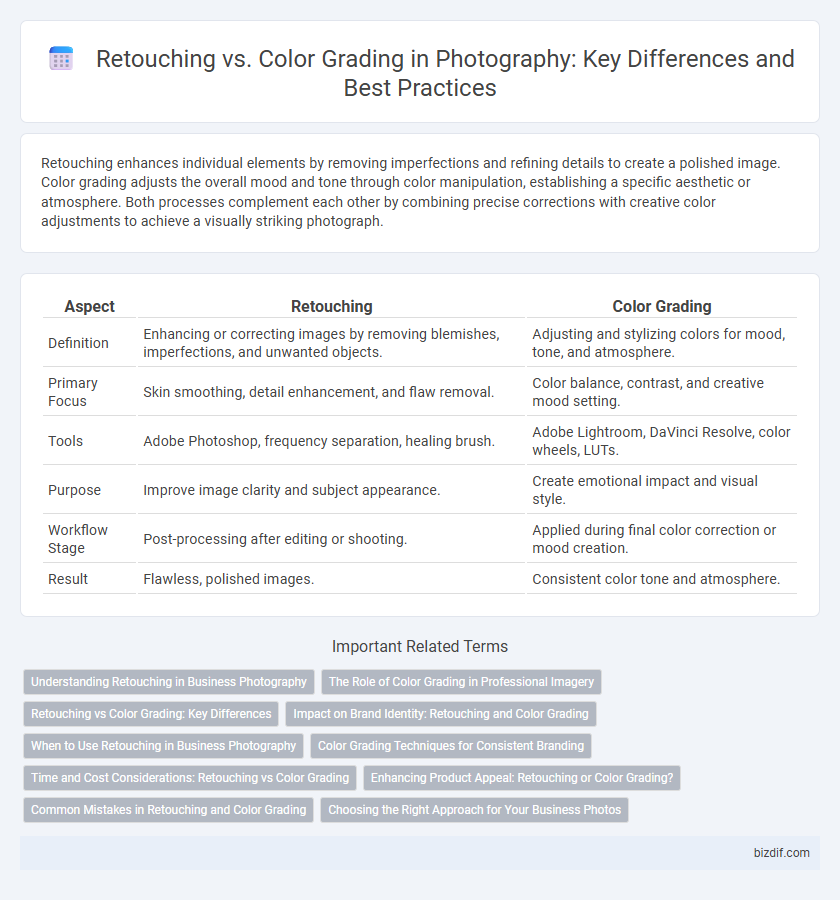Retouching enhances individual elements by removing imperfections and refining details to create a polished image. Color grading adjusts the overall mood and tone through color manipulation, establishing a specific aesthetic or atmosphere. Both processes complement each other by combining precise corrections with creative color adjustments to achieve a visually striking photograph.
Table of Comparison
| Aspect | Retouching | Color Grading |
|---|---|---|
| Definition | Enhancing or correcting images by removing blemishes, imperfections, and unwanted objects. | Adjusting and stylizing colors for mood, tone, and atmosphere. |
| Primary Focus | Skin smoothing, detail enhancement, and flaw removal. | Color balance, contrast, and creative mood setting. |
| Tools | Adobe Photoshop, frequency separation, healing brush. | Adobe Lightroom, DaVinci Resolve, color wheels, LUTs. |
| Purpose | Improve image clarity and subject appearance. | Create emotional impact and visual style. |
| Workflow Stage | Post-processing after editing or shooting. | Applied during final color correction or mood creation. |
| Result | Flawless, polished images. | Consistent color tone and atmosphere. |
Understanding Retouching in Business Photography
Retouching in business photography enhances image quality by correcting imperfections such as skin blemishes, lighting inconsistencies, and background distractions to create polished, professional visuals. Precise retouching ensures brand representation remains strong, maintaining a consistent corporate image across marketing materials and digital platforms. Skilled retouching improves client perception and engagement by delivering visually appealing photographs that highlight product and personnel excellence.
The Role of Color Grading in Professional Imagery
Color grading enhances professional imagery by adjusting tones, contrast, and color balance to evoke specific moods and emphasize narrative elements. Unlike retouching, which focuses on correcting imperfections and refining details, color grading transforms the overall aesthetic to create a cohesive visual style. Mastery of color grading techniques is essential for photographers aiming to produce compelling and emotionally resonant images.
Retouching vs Color Grading: Key Differences
Retouching in photography primarily focuses on enhancing individual elements within an image by removing imperfections, adjusting skin tones, and refining details to achieve a polished look. Color grading, on the other hand, involves altering the overall color palette and tonal mood of the entire image for stylistic or cinematic effect. While retouching targets localized corrections, color grading affects the global aesthetic, making their purposes and techniques fundamentally different.
Impact on Brand Identity: Retouching and Color Grading
Retouching enhances brand identity by refining images to present a polished, flawless appearance that aligns with the brand's desired aesthetic and quality standards. Color grading establishes mood and tone through consistent color schemes, reinforcing brand recognition and emotional connection with the audience. Combined, retouching and color grading create distinctive visual narratives that strengthen brand identity across marketing materials and platforms.
When to Use Retouching in Business Photography
Retouching is essential in business photography when enhancing portraits for corporate profiles, marketing materials, or professional websites to ensure a polished, flawless appearance that reflects brand professionalism. It focuses on removing imperfections, smoothing skin, and adjusting facial features while maintaining natural textures, which builds trust and credibility with clients and partners. Use retouching selectively to balance authenticity and visual appeal without over-editing, preserving the subject's genuine expression.
Color Grading Techniques for Consistent Branding
Color grading techniques for consistent branding involve adjusting hues, saturation, and luminance to create a unified visual aesthetic across all images, enhancing brand recognition. Using tools like LUTs (Look-Up Tables) and color profiles ensures reproducible color schemes that align with brand identity guidelines. This process maintains mood and tone, reinforcing the emotional impact of the visuals while preserving image quality and coherence.
Time and Cost Considerations: Retouching vs Color Grading
Retouching often demands more time and higher costs due to detailed adjustments like skin smoothing and object removal, requiring advanced skills and meticulous attention. Color grading typically involves global changes to mood and tone, making it faster and more cost-effective for overall image enhancement. Choosing between retouching and color grading depends on project deadlines and budget constraints, balancing the need for precision against efficiency.
Enhancing Product Appeal: Retouching or Color Grading?
Retouching sharpens product details, removes imperfections, and enhances textures to create a flawless and polished appearance that appeals directly to consumers. Color grading adjusts tones, hues, and contrasts to set the mood, emphasize brand colors, and establish a consistent visual style that attracts attention. Both techniques are essential; retouching perfects the image at a micro level while color grading elevates overall aesthetic impact, boosting product appeal strategically.
Common Mistakes in Retouching and Color Grading
Common mistakes in retouching include over-smoothing skin textures, resulting in unnatural appearances, and inconsistent lighting adjustments that disrupt image realism. In color grading, errors often involve excessive color saturation or poorly balanced tones that obscure the intended mood. Properly distinguishing retouching from color grading ensures a polished yet authentic final photograph.
Choosing the Right Approach for Your Business Photos
Retouching enhances individual photo details by correcting imperfections and refining features, making it ideal for portrait-focused business photography. Color grading adjusts the overall color palette to establish a consistent mood and brand identity across a photo series, which is crucial for marketing and product shoots. Selecting between retouching and color grading depends on whether your business prioritizes flawless subject representation or cohesive visual storytelling.
Retouching vs Color Grading Infographic

 bizdif.com
bizdif.com